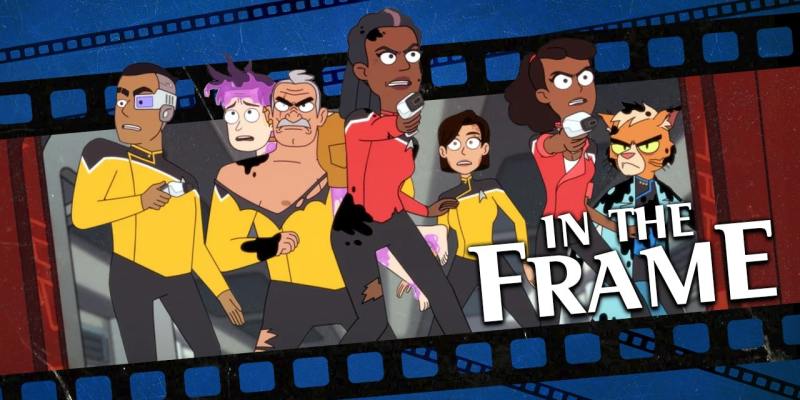Star Trek: Lower Decks launched late last week.
On the surface, Lower Decks marks a departure for the Star Trek franchise. It is the first animated foray into the Star Trek universe since The Animated Series resurrected Kirk and the crew as a Filmation series between 1973 and 1974 – and even that is often treated as a franchise footnote, to the point it was pushed (mostly) out of continuity. Lower Decks is also the first Star Trek series to be positioned primarily as a comedy series, animated in the “CalArts” style of Rick & Morty.
Appearances can be deceptive. Lower Decks doesn’t really feel like a new departure. If anything, it feels like the most traditional of the latest generation of Star Trek shows. It is an affectionate love letter to The Next Generation. Despite being set a year after the events of Nemesis, the characters dress in slightly modified variants of Next Generation costumes. The theme opens with a quote from Jerry Goldsmith’s iconic Next Generation score. Even the credits font is from The Next Generation.
This is not a surprise. Although pre-release publicity for Lower Decks made a big deal of showrunner Mike McMahon’s background on Rick & Morty, the writer actually cut his teeth with the endearing “TNG Season 8” Twitter account that imagined a new season of the Star Trek show that built off its… somewhat esoteric final season. TNG Season 8 was a work of affectionate celebration of the goofiness of The Next Generation that understood the weirdness was part of the appeal.
Between Lower Decks and Picard, The Next Generation makes sense as an object of nostalgia. While more hardcore Star Trek fans, your humble writer included, might argue that Star Trek reached its zenith with Deep Space Nine, there’s a solid argument that the franchise’s popularity peaked with The Next Generation. Ronald Reagan visited the set of the 100th episode. The show’s final season became the rare genre show (at the time) to get an “Outstanding Drama” nomination at the Emmys.

There is some small irony to Lower Decks. Since the launch of Discovery and Picard, there has been a vocal contingent of fans yearning for a nostalgic return to the franchise’s halcyon days. Given the age of these fans, that golden age spanned from about 1987 (really 1989) to 1994. Those fans reject what they see as the cheapening of the brand, the move away from episodic storytelling and the tempering of the franchise’s utopia to reflect the murkier world in which the shows now exist.
Lower Decks exists to service that nostalgia. Indeed, there’s a tangible argument to be made that the sort of utopian idealism associated with the post-Cold War and pre-War on Terror Star Trek makes more sense on a modern half-hour sitcom than a modern hour-long drama. However, those fans most desperately wanting that traditional and nostalgic dose of Star Trek are the most likely to be put off by “characters shrieking ‘Boom, surprise bitch!’ and pointing finger guns.”
However, the problem with Lower Decks is not transgression, but familiarity. The show is populated by the sort of jokes that Star Trek fans have been making among themselves for decades. The opening episode finds Ensign Rutherford (Eugene Cordero) on an awkward date that recalls similar subplots for Geordi La Forge (LeVar Burton) in episodes like “Booby Trap” and “Transfigurations,” which is a relatively deep cut of a plot reference.
A later episode focuses on the cleaning of the holodeck, an old Something Awful gag. Lieutenant Shaxs (Fred Tatasciore) begs to be allowed to use weapons only to be shot down, just like Lieutenant Worf (Michael Dorn). Some of the gags are even recycled directly from earlier Star Trek shows. When Ensign Mariner (Tawny Newsome) offers Ensign Tendi (Noël Wells) a glimpse of delightfully decadent female pleasure on the holodeck, it evokes a similar scene from “The Way of the Warrior.”

The subversion of Lower Decks is extremely limited. “Second Contact,” the first episode, demonstrates an interesting formula: a traditional Star Trek plot with the emphasis shifted. The crew of the USS Cerritos is infected by a pathogen that turns the crew into monsters. This is a standard Star Trek setup, one particularly common in the Berman era and favored by writer Brannon Braga. It is the basic plot of “Genesis,” but it also recalls stories like “Threshold” or “Macrocosm.”
Many of the jokes in “Second Contact” are jokes about episodes like “Genesis.” Restored to normal, Commander Ransom (Jerry O’Connell) screams, “Did I eat flesh?” It’s a joke about the fact that Worf appears to have killed (and maybe eaten) at least one crewmember over the course of “Genesis,” but nobody talks about it. Again, it’s a joke that reflects an affection for Star Trek, even at its silliest. However, it’s also something that fans have been pointing out since “Genesis” aired in March 1994.
Lower Decks makes a lot out of the idea that its characters are not the best and brightest Starfleet has to offer. They are “second contact” specialists. The joke is that they are the screw-ups and the losers of the Star Trek universe. However, Lower Decks refuses to commit to that. The characters in Lower Decks might be a little more neurotic than usual – and they might party harder or talk faster – but they are still both fundamentally decent and basically competent.
“Second Contact” is even structured as a Next Generation episode. It is an episodic adventure with two plots running in parallel. Ransom accidentally brings the pathogen on board, where it wreaks havoc. Meanwhile, Mariner and Ensign Boimler (Jack Quaid) have an encounter with a strange alien spider during a trip to a planet surface. The two plots dovetail neatly when the spider’s milk cures the pathogen, which is itself a very Next Generation resolution in terms of story structure.

More than that, Lower Decks still exists within what the writers describe as “the Roddenberry Box,” the utopian ideal that Gene Roddenberry established for The Next Generation – and that many of his writers openly hated. The Roddenberry Box assumes that people are fundamentally good and will work together for a greater cause. It believes that humans are the very best that they can be, even in bad situations. It minimizes interpersonal conflict and prevents immoral behavior.
For all the show’s use of sarcasm and snark, Lower Decks takes place much further inside “the Roddenberry Box” than Deep Space Nine – which allowed for tension between the cast to great effect. There is some debate about whether good drama requires character conflict. After two years, the writers on The Next Generation got good enough at working around it. However, conflict is absolutely essential for comedy, especially character-driven television sitcoms.
It’s notable that the two consistently funniest Star Trek shows existed outside the Roddenberry Box. In its late first and early-to-mid second seasons, The Original Series was overseen by “the forgotten Gene” L. Coon. Coon was responsible for a lot of what modern Star Trek fans take for granted, including the Klingons, the Prime Directive, and the United Federation of Planets. Coon was responsible for episodes like “Errand of Mercy,” which suggested Starfleet was as expansionist as the Klingons.
Coon pushed for more humor in the show, recruiting a young writer named David Gerrold to rewrite an android comedy titled “I, Mudd” and to write the Cold War spoof “The Trouble with Tribbles.” Coon himself wrote “A Piece of the Action,” in which Kirk (William Shatner) sets himself up as a 1920s Chicago gangster collecting kickbacks for the Federation. Roddenberry hated the addition of humor to Star Trek, and it may have played a role in Coon’s departure.

Similarly, Deep Space Nine was able to milk a lot of humor from the dysfunctional relationships between its cast – from the culture clash between working class Miles O’Brien (Colm Meaney) and enthusiastic officer Julian Bashir (Alexander Siddig), to straight-laced cop Odo (Rene Auberjonois) and failed con artist Quark (Armin Shimerman). The show produced some fantastic comedy episodes: “Little Green Men,” “Trials and Tribble-ations,” “Take Me Out to the Holosuite.”
The Next Generation was never as good at comedy as either The Original Series or Deep Space Nine, because it was never as impertinent. There is plenty of material in the Star Trek universe worthy of mockery, as the earlier shows have proven. Coon frequently mocked the franchise’s overeager embrace of American self-image in scripts like “A Piece of the Action.” Deep Space Nine ridiculed the franchise’s fetishization of warrior cultures like the Klingons in “The House of Quark.”
Star Trek shows traditionally take a year or two to find their feet. Maybe Lower Decks will grow into a Star Trek comedy series with teeth. It would be nice to see a Star Trek show willing to take aim at the self-important “Oh, how terrible is it for us to watch millions of other people die?” angst of Prime Directive episodes like “Pen Pals” or “Homeward” or to call out the franchise’s long-standing irrational fear of unconventional life forms like shape-shifters, androids, or holograms.
However, that would require a genuine irreverence rather than just the appearance of transgression. Such an approach would demand a willingness to treat The Next Generation and its spin-offs not just as a nostalgic fetish object, but as material worth actively engaging with.
